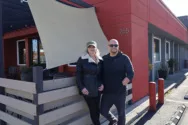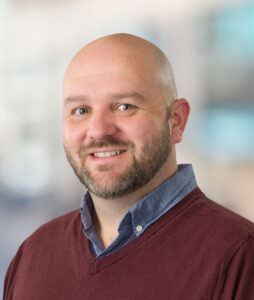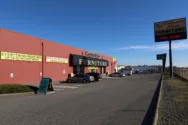
Home » New Ams owner reopens talk of replacing Toyota Center
New Ams owner reopens talk of replacing Toyota Center
Hockey team owner signs lease through 2029

Jon Sortland, who became the majority owner of the Tri-City Americans in November 2024, said he’s committed to keeping the hockey team in the Tri-Cities. But he’s also hoping that the team’s home ice at the Toyota Center can get an upgrade in the future, both to improve the fan experience and provide more entertainment opportunities overall to the community.
Photo by Ty BeaverApril 14, 2025
The recently concluded 2024-25 Western Hockey League season was one of the better ones in recent years for the Tri-City Americans.
The team won more than half of its games and while the Ams didn’t make it past the first round, they still earned a playoff berth. It was also the first season with the team’s new majority owner, Jon Sortland.
Sitting in the team’s private box above the rink, Sortland recently told the Tri-Cities Area Journal of Business he is excited for the team’s future in the Tri-Cities. Next year’s team will be stronger, he said, thanks to some high draft picks.
But he’s not banking on more wins to be the only way to fill seats. Already this past season he and the other owners started tinkering with aspects of the spectator experience as part of efforts to bring attendance levels back to the peaks experienced in the 1990s.
“It’s a lot more fun and more festive when the building is full,” he said. “It’s all about creating a fun game experience that draws people.”
And he’s hoping a new venue for the team can be a part of that renaissance. Sortland recently told the Tri-Cities Hispanic Chamber of Commerce that a bond initiative to help pay for the Toyota Center’s replacement could go before voters as early as 2028.
However, Sortland has not yet had formal discussions with the Kennewick Public Facilities District, which oversees the facility on behalf of the city of Kennewick. And Corey Pearson, executive director of VenuWorks, the company that manages the Toyota Center’s day-to-day operations, said there’s work to do before any dirt is moved to make way for a new venue, which would cost an estimated $150 million to $200 million.
“We’ve always got our eye on the future. We just have to do things smart and sustainably,” Pearson said.
A history of highs and lows
The Americans have been part of the Tri-Cities since 1988, when the team had to play much of the first half of its season on the road as what is now the Toyota Center was still under construction.
The team’s fortunes have waxed and waned over the years. Its best seasons and playoff runs came in the 2000s and 2010s, including a three-year run as the top U.S. team in the Western Hockey League and winning two-thirds of its games. The team still holds the record for the most 40-win seasons in the league, the most recent nearly 10 years ago.
There also have been low points, with a tense relationship between a past owner and the community that led to threats of the team being relocated and four sub-500 records out of the past six seasons.
Game attendance also has suffered. Americans games currently garner an average attendance of 4,000 spectators, Sortland said, down from 4,500 10 years ago and even further from the nearly 5,000 attendance average set during the team’s best seasons.
However, that decline in attendance hasn’t demonstrably hurt the Toyota Center’s revenues. The team brings in half of the total visitors to the venue every year, Pearson said. That’s less than in the past but that’s been a good thing for the Toyota Center, as VenuWorks has worked with the team to get back dates so other events and performances can be held at the facility.
And while it’s not 100% clear how broad the team’s economic impact is on the community, it is significant, said Hector Cruz, vice president of development and community engagement for Visit Tri-Cities.
“They are a big part of what we do,” he said of the agency’s sports tourism marketing efforts.
Connecting with community
Sortland was adamant in his comments to the Hispanic chamber and the Journal that he will never move the Americans, new venue or not. Pearson confirmed that Sortland reupped the team’s lease through 2029 when he purchased his majority stake. Sortland also has moved to the Tri-Cities from Seattle himself.
“I can assure you, over my dead body, this team isn’t going anywhere,” Sortland told the chamber.
The former tech startup businessman said he spent much of the last season observing team operations, including how things are done in-game, making some tweaks and looking at what to do in the future.
Among those tweaks are Sing-Along Saturdays, when fans are invited to join in with classic songs during intermissions at Saturday games. The Americans are also using the video board for boosting fan engagement by showing bloopers, player interviews and highlighting fans in the stands.
“We’re not going to win every game, but you can still have fun,” Sortland said.
Off the ice, the team’s sales and marketing team was beefed up to facilitate a more proactive approach to selling ticket packages and promotions.
And Sortland said he intends to be the team’s biggest booster in the Tri-Cities while getting the team involved with local nonprofits and other organizations.
“We need to take very seriously our role in the community,” Sortland said.
More than hockey
While it was state-of-the-art back in the late 1980s, the Toyota Center’s few box seats, relatively narrow concourses, lack of a center scoreboard and a technologically outdated press box don’t compare to what other WHL teams have or what fans expect, he said.
Those are deficits that haven’t gone unnoticed by spectators. Canadian hockey fan Kevin Jordan manages the online WHL Arena Guide and attended an Americans game at the Toyota Center in 2022 as part of his goal to visit every arena in the league. He also cited the same issues voiced by Sortland.
“This isn’t Wenatchee’s amateur hour; Tri-City at least feels like their AV is done by professionals, but they could do a lot more with what they have,” Jordan wrote.
Improved venue
Sortland said he met with a handful of Americans players about their experiences at the Toyota Center. They love the team, but not the cramped locker rooms and lack of a player’s lounge. And when Sortland proposed to VenuWorks that he pay to convert a room to such a lounge, it was a no-go because it was needed for other purposes and lacked utility access.
“There’s just not enough space below,” Sortland said.
A new and improved venue could address all the issues the Americans have while also making the Toyota Center better for the other events and performances it hosts the rest of the year, he added.
It’s a sentiment that Pearson said he doesn’t disagree with. With acts such as Peter Frampton and Pitbull coming to the Toyota Center recently, VenuWorks has raised conversations with the city about the quality of a venue they want those performers to see, Pearson said.
And while Three Rivers Convention Center is expanding to include space that could accommodate sports tournaments, Cruz said there is still a need for a large arena to hold marquee events, such as collegiate sports games and tournaments.
“You need upgraded seats, upgraded infrastructure to hold those events,” he said.
Past efforts
Ambitions of replacing the Toyota Center have been around for years. City planning documents reference it at least as far back as 2012 and a visioning document for the Three Rivers Campus – which includes the Toyota Center and the neighboring Toyota Arena and Three Rivers Convention Center – has a 12,000-seat venue in a projected site map of the campus where the Toyota Center currently sits. A similar new facility was in the campus master plan approved by the Kennewick City Council in 2023.
“I came to the Tri-Cities in 2009 and the city manager at the time told me he wanted a new Toyota Center in five years,” Pearson told the Journal.
Efforts to replace the building have fallen short, though. Bonds financed by sales tax increases that would have expanded the Three Rivers Campus, which included replacing the Toyota Center, were rejected by voters in 2016 and 2017.
Those bond failures led to questions about whether the Americans could stay, as the WHL has facility requirements that weren’t being met with the Toyota Center. In the end, the city agreed to make upgrades, such as adding video boards and improving the ice making equipment, to resolve the league’s concerns.
Sortland told the Hispanic chamber that any impact on the local community from a future bond would be minimal, saying the region’s lodging tax revenue would be able to cover the bulk of replacing the Toyota Center.
That’s comparable to the current arrangement paying for the $71.3 million convention center expansion. It’s being paid for with a combination of bonds, local government funds and existing city tax revenue, including lodging tax dollars. Construction is scheduled to finish in the fall of 2026.
But Pearson said that funding structure wouldn’t work for a project as big as a new Toyota Center. A new, larger venue would require ancillary projects, such as demolishing the current facility to build on top of it and adding a parking garage to accommodate larger crowds.
A sales tax increase of two-tenths of a percent is still the most feasible way to pay for a new Toyota Center, Pearson said. And the feel is that the community would support that, despite past rejections because it was the convention center expansion that people didn’t want to pay for.
“The message was, if you tell us you’re going to redo or replace the Toyota Center, you have our attention,” Pearson told the Journal.
But there still has to be bandwidth for the project, which Pearson said is at capacity when it comes to the city. It already has some big capital projects it’s preparing for, including a new city hall and a new fire station to serve the burgeoning Southridge area.
“I don’t believe the Toyota Center is on that list so we have some work to do,” Pearson said.
Here to stay
If push comes to shove, Sortland said the Americans will make do with what the Toyota Center offers. It’s a classic junior league hockey arena and that can be a marketable experience in and of itself, Sortland said.
And while a more modern facility could draw in more casual fans, the Americans have a pretty dedicated fan base already, Sortland said, a fact not missed by Jordan when he visited the Tri-Cities.
“I didn’t have high hopes for the atmosphere in Tri-City – I chose to attend a rare Monday night game against an opposite conference rival, when I knew the noise would likely be less than it could have been – but Tri-City’s crowd, though small, was still loud and into the game,” Jordan wrote in WHL Arena Guide. “I find the atmosphere at American rinks is generally better than at Canadian ones anyway, but Tri-City blew me away considering the small Monday crowd. So, kudos to those fans.”
Local News Arts & Culture Hospitality & Meetings
KEYWORDS April 2025
Related Articles
Related Products





